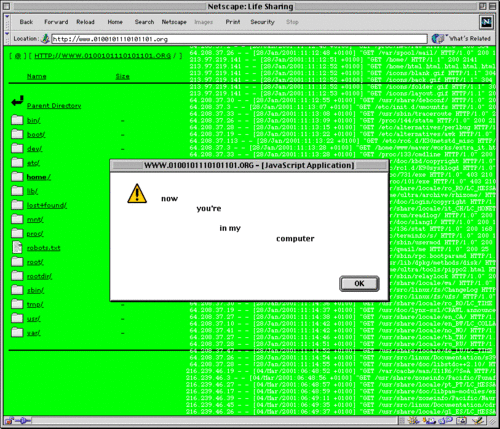Technologies: Debian GNU/Linux, HTML, Javascript, Flash, Python
Current URL:Â http://0100101110101101.org/home/lifesharing/index.html
Wikibook Chapter: https://wiki.brown.edu/confluence/display/MarkTribe/0100101110101101.org
Much as an office with its books, correspondence, and files reflects the interests and activities of its occupant, so, too, the contents of a personal computer can be seen as an intimate portrait of its owner. Because our computers contain so much personal information, we protect them from prying eyes with passwords, firewalls, and encryption software. In Life Sharing, a project commissioned by the Walker Art Center in Minneapolis, the European New Media art duo 0100101110101101.ORG, a.k.a. Franco Birkut and Eva Mattes, turned their private lives into a public art work. From 2001-2003, they made each and every file on their computer, from grant proposals to incoming e-mails, available to anyone at any time via their Web site. This daring piece, whose title is an anagrammatic play on the term “file sharing,” is an exercise in transparency, an act of data exhibitionism on the part of the artists that turns viewers into voyeurs
In an era of privacy paranoia, government spying on its own citizens, identity theft as a familiar problem, the idea behind Life Sharing may be more radical today.Â

Was this such a naive time? Maybe less titillating, Life Sharing creators Eva and Franco Mattes went far beyond the voyeuristic camera eye view into student Jennifer Ringely who launched JenniCam in 1996, posting regular still images every 3 seconds to the web, stopping in 2003.
Putting your mundane and private moments on the web as snapshots is one thing, letting anyone use your computer, read your email, access your financial records seems much more naked then Jenny.
In January 2001 we started sharing our personal computer through our website. Everything was visible: texts, photos, music, videos, software, operating system, bank statements and even our private email. People could take anything they wanted, including the system itself, since we were using only free software. It was not a normal website, you were entering the computer in our apartment, seeing everything live. It was a sort of endurance performance that lasted 3 years, 24/7.
Previously we were re-using and mixing other people’s work, while now we were sharing everything with everybody.
Working with a computer on a daily basis, over the years you will share most of your time, your culture, your relationships, your memories, ideas and future projects. With the passing of time a computer starts resembling its owner’s brain. So we felt that sharing our computer was more than sharing a desktop or a book, more than File Sharing, something we called Life Sharing.
No social network existed at the time, and Life Sharing felt rather absurd, if not plain wrong.
While no longer directly available, the archive site provides screenshots of what the system looked like and samples of its content. The Mattes extended the project by wearing GPS transmitters which posted their location as well to the server.

And they also connected their mobile phones to the server so anyone could monitor their conversation.
This may sound preposterous to borderline (or well over the border) insanity, but how brave is the world of art to reverse the typical fear of loss of privacy, to make their lives a question of— what it it totally did not exist? If everything is available, does that mean privacy is a non-entity?
A New York Times article from 2001, ARTS ONLINE; Your Life Is in Your Computer, for Everyone to See suggests the intent of the project
Despite this cautionary note, the project is meant to illustrate a utopian alternative to living online behind a wall of digital defenses. The couple champion the open-source computing movement, which is based on freely available, communally developed software instead of commercial products.
As copyright holders struggle to preserve the integrity of their intellectual property on the Internet, the artists are offering their creative activities to all comers, with no fees involved. Because the programs on their computer are openly available across the Net, copyrights are not violated when they are downloaded.
You can see on their web site today, a plain as plain theme a WordPress blog can have, the continued arc of this work via Our Work Got Stolen – is it life imitating life imitating art? Their gallery installation was stolen, and all that is left is a laptop on a madder with footage of the theft.


